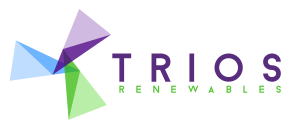
The TRIOS Model
TRIOS is our in-house offshore wind operational performance model which lies at the core of our services.
The academic open-source roots of our model go back to 2011. The works were first published in 2012 and improved upon over the following years, adding new modules and functionality. Thorough validation and benchmarking exercises against other widely used models have been published. The open-source base model itself is maintained by a community of academic users and students, where it is used in benchmarking exercises but also adapted for futuristic operational scenarios and technologies. The Trios team takes an active role in bringing these projects to fruition, which in turn is an opportunity to implement the latest findings in the services available to our customers.
Model classification and principles
The TRIOS model belongs to the time series Monte Carlo family of operational models. “Time series” in this context means that it is an iterative model: it simulates the state of each entity across the wind farm (including turbine components, vessels, staff, etc.) for every timestep throughout its life. “Monte Carlo” means that the above model is run repeatedly with the same input parameters, producing a range of different possible outcomes and so allowing the output variance and model convergence to be quantified. Normally anywhere from 30 to 100 parallel streams are run to achieve convergence and summarise the results. Mostly it is reasonable to simulate at a 1-hour resolution – therefore for each parallel stream in a scenario with a 30-year site lifetime, the entire site would be simulated 262800 times and all the failure events, repairs, downtime, generated energy, and other variables would be recorded.
There are a few noteworthy distinctions from other common model families.
Firstly, the TRIOS approach should not be confused with a Markov model. System states in the TRIOS model are, as on a real site, a deterministic result of different parameters and events, past and present – a gearbox, for example, can only be replaced when a replacement has been deployed by a suitable heavy lift vessel along with enough technicians, they have had enough time to do the job, and the weather has allowed it. On the other hand, system states in a Markov model are probabilistic and depend on the current state alone – the repair of that same gearbox would not have to wait to meet all the preconditions given above, but could rather happen after a failure at any given timestep with a certain low probability that is derived from input data.
Secondly, TRIOS should not be confused with numerical models – that approach captures the entire outcome of site operations in a complex set of equations, which are then solved all at once for a given set of parameter values. TRIOS, on the other hand, models every event discretely. In both comparisons, the approach used by TRIOS provides a clear advantage in modelling resolution and adaptability to incorporate any number of relevant variables.
Stochastic factors
Timesteps and events are modelled discretely in TRIOS. Yet there are still stochastic factors at play. Failures, for example, do not happen at predetermined times but are instead simulated for each timestep according to a per-component hazard function. This means that where sufficient data is available, a bathtub curve could be used for each turbine component for a most realistic representation of failures across the life of an asset. Otherwise, a constant failure rate can also be used. However, the operational uncertainty and workability at any offshore wind site is still primarily driven by the weather. The core feature of TRIOS is its advanced weather model which learns every individual site’s stochastic metocean profile based on input data. In the best case, in-situ measurements of significant wave height (Hs) and wind speed would be used; as these are rarely available however, it is possible to use NWP or hindcast data as a substitute. This level of detail makes the TRIOS model suitable for evaluating the finer details of site operations, vessels or turbine technology choices.
Adaptability
When the TRIOS model was first built on its open-source foundations, it was decided that any new development work should focus on modularity. Each added capability developed since then – be it added resolution in vessel movements, tow-to-shore process model to enable floating sites to be accurately represented, or specific novel turbine taxonomies – is effectively plug-and-play, ready to be implemented in new case studies as required. The underlying framework was also updated so that any necessary new development for future projects can be accommodated painlessly, agnostic of site, technology, or the analytical problem at hand. Running the model at its current level of detail is computationally demanding and normally takes several hours per site. The TRIOS code base is developed in Matlab, meaning that it is guaranteed to be optimised for the job and reliable for a timely project delivery.
